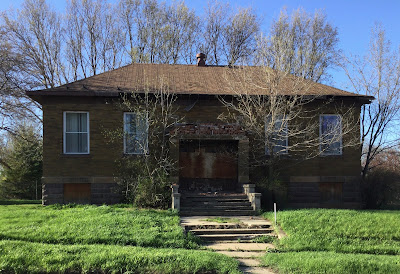
I was romping along thanks to an end-of-the-day strong tailwind from the south that I was enjoying as best as I could what with a storm due to hit at six p.m. The sky to the west was darkening while ahead and to the east the sky was a pale blue. I was hoping I might be able to outrace the storm and gobble up as many miles as I could before dark taking advantage of this rare assist.
At five-thirty a motorist heading south stopped in the road and the driver, a woman, ducked her head out of the window and shouted, “There’s a bad storm coming!” I continued riding pellmell monitoring the clouds closing in on me until a glance caught the image of pitch dark just behind me. I should have realized the strong wind from the south was blowing in the storm and been monitoring the southern sky more than that to the west.
There was a recreational area along a lake four miles ahead that I had been considering as a campsite if I couldn’t ride further. That didn’t look as if it would come soon enough. After a mile a cluster of tall fir trees beckoned, but it was surrounded by a barbed wire fence. A mile further a small deciduous forest separating the road from a wheat field had no barrier, so I slipped into it just as the rain started and the wind accelerated and seemed to gust from all directions.
I thought I was saved, but the slim canopy of trees was no match for the lashing rain. I was well-drenched by the time I set up my tent and had quite a bit of water to soak up within the tent that had gathered before I got the rain fly on. Once I got all my gear in I shed my dripping Goretex jacket and removed my saturated shorts. I dried my legs and proceeded with the task of draining the pools of water within the tent.
I put to use an oversized black neckerchief with red trim I had found along the road the day before, the first of the trip. My socks were wet, so I used them too, as their fluff was better at absorbing the water. My torso was perfectly dry thanks to my Goretex jacket. I just needed to slip on my wool sweater and I was toasty warm as the rain continued to stab and bounce off the tent.
I tried not to begrudge that fence around the first forest, as I would have had the tent set up before the storm hit if I could have slipped into it, but at least there had been a second forest and I was spared of riding in the fury of the storm. I would have been a test for every motorist who passed whether they should rescue the poor soul on the bike. As it was, they all should have been stopping to offer me refuge as the storm bore down. I could well have led to some marital strife as a sympathetic female suggested stopping and the male at the wheel thought otherwise.
The rain stopped before dark and I was able to hang my dripping wet gear on the bike. These storms pass quickly, though their slightly diminished winds can continue for days, festering for another assault. The black sky of the storm makes them easy to spot and attracts storm-chasers from all over. Two days ago the Washington Post ran a story about a storm-chaser from Mexico City who was killed twenty miles from the Carnegie Library in Luverne, Minnesota the day after my visit. She was traveling with three other storm-chasers, two from Chile, and had pulled off the road to avoid downed power-lines and was struck by a tractor-trailer.
My shorts hanging on my bike had dried enough to wear in the morning. The rest of my gear quickly dried when I laid them out in the sun during my first rest stop, though I had to secure them so they wouldn’t blow away. The day of the storm included just one Carnegie, as they have become more spread out as I head north. It came in Brookings, a larger town, somewhat thanks to the presence of the South Dakota State University.
A graduate student in the business school passing by the Carnegie commented, “It looks like you’ve been everywhere,” as that was among his aspirations. He’d already been to thirty-five states, but no foreign countries. I told him I hadn’t been everywhere, but almost, just throwing out Oman and Madagascar and the Philippines. He didn’t really expect to hear that, as he’d been more figurative than literal in his reaction to my loaded bike, and was at a loss for words, just wishing me “good luck” and continuing on his way.
The artist’s statement (Alan Scott Milligan of St. Paul, Minnesota) on a plaque across from the roundabout, explained that it was a Cloud Horse—“a family of horses running fast and wild as low-bearing clouds, as the glacial waters which once covered this land.” A community with the sensitivity to commission such art ought to have the initiative to preserve its Carnegie.






No comments:
Post a Comment